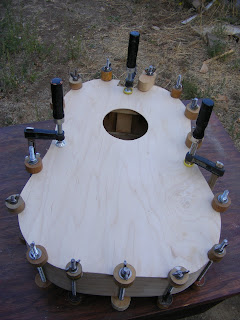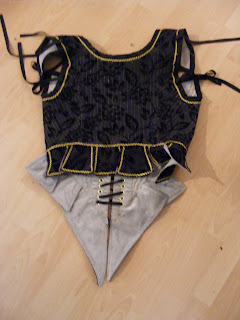 Photo taken on the weekend before the Canadian long weekend know as Victoria Day n May 2011. It has been given the name the beast, but it is a little sweetheart to set up and take down at Medieval events, however one needs an area approx. 30 ft x 40 ft to set up the beast, because of the guide ropes to hold the pavilion stable. At this particular event wind gust were estimated at 80K on Saturday, of which one person's popup pavilion did decide to leave the ground. This style based off of medievel research seems to prove that this style can take the stress of wind gust.
Photo taken on the weekend before the Canadian long weekend know as Victoria Day n May 2011. It has been given the name the beast, but it is a little sweetheart to set up and take down at Medieval events, however one needs an area approx. 30 ft x 40 ft to set up the beast, because of the guide ropes to hold the pavilion stable. At this particular event wind gust were estimated at 80K on Saturday, of which one person's popup pavilion did decide to leave the ground. This style based off of medievel research seems to prove that this style can take the stress of wind gust. The sun porch - also the cook area for outdoors, is attached to the 12 spoke pavilion and serves as a grand entrance to the pavilion. The brown box in the background is used to hold the canvas of the pavilion and does require 2 box measuring aprox. 32 inches length x 16 inches high x 19 inches wide. Reason for these dimessions is for earier packing on the 3/4 ton truck, and helps to make a level platform when the furinture is packed beside it, and on top. No wasted space in packing. The second box mention is for the inner drapery panels, divider drapes, and the bed canopy for those cold evening nights.
The sun porch - also the cook area for outdoors, is attached to the 12 spoke pavilion and serves as a grand entrance to the pavilion. The brown box in the background is used to hold the canvas of the pavilion and does require 2 box measuring aprox. 32 inches length x 16 inches high x 19 inches wide. Reason for these dimessions is for earier packing on the 3/4 ton truck, and helps to make a level platform when the furinture is packed beside it, and on top. No wasted space in packing. The second box mention is for the inner drapery panels, divider drapes, and the bed canopy for those cold evening nights.
The sitting area, using furiniture that Mistress Christiana built perviously except for the brass table which was a gift from a friend, when he moved to Sask. The heraldry in the background was used in SCA events, but now is retired, as Mistress Christiana has new heraldry to take its place. Photos of the heraldry will be taken at a later date, as the flags, will take time to make.

Looking way up we see the basic frame that makes the 12 spoke medieval pavilion possible. These are secured by holes drilled into the tinkertoy where all the spokes come together on the main pole. Further guide ropes are used to secure and transfer the load to the center post, and hairpin keepers are inserted thought holes at the top of the tinkertoy and through a slot that is on each of the spokes. This prevents possible failure of the spoke coming out of the pocket hole in the tinkertoy and allows for the installation of the sun porch so that the weight and wind drag does not pull out the spokes; in this case 5 spokes are involved.
 The inner linning which is attached to outer panels and in between is a water proof membrane that prevents mositure from coming from outside into the inside, especially during showers and rainstorms. The membrane also serves another purpose and that is to prevent the wind from blowing through the threadcount of the fabric panels. There is three panels with a possible openning to allow for hot days, and allow the breeze to travel through and keep the pavilion cool, but on those cold evenings these openning can be closed, and heat retained because of the membrane and the inner pannel serving as insulation. Below is the ground mat made of the same material that the wall membrane is made of and prevents mositure from coming up through the ground, and to be able to keep ones feet dry. Just don't spill anything on it as it will not allow the spill to seep into the ground, and this is the reason why it is cut short of the walls, so that rainwater does not have a way to travel inside the pavilion.
The inner linning which is attached to outer panels and in between is a water proof membrane that prevents mositure from coming from outside into the inside, especially during showers and rainstorms. The membrane also serves another purpose and that is to prevent the wind from blowing through the threadcount of the fabric panels. There is three panels with a possible openning to allow for hot days, and allow the breeze to travel through and keep the pavilion cool, but on those cold evenings these openning can be closed, and heat retained because of the membrane and the inner pannel serving as insulation. Below is the ground mat made of the same material that the wall membrane is made of and prevents mositure from coming up through the ground, and to be able to keep ones feet dry. Just don't spill anything on it as it will not allow the spill to seep into the ground, and this is the reason why it is cut short of the walls, so that rainwater does not have a way to travel inside the pavilion.
The entrance to the pavilion, which allows for a wide openning and thus allows for movement of furniture with a dolly, and room to move in setting up. When the drappery is added, there is basically four sections in the pavilion; the solar - medieval term for bedchamber; the dressing room; the sitting room, and finally a storage room that is contained behind the headboard, and is accessable by the sitting room.
A model of the spoke frame work for a new tent. As Mistress Christiana prepare to build a new pavilion, and retire the three pavilions. Christiana have now (mainly the seams of the canvas is shot from wear and tear) started to design a new pavilion that is completed May of 2011. In mundane life Christiana design houses and furniture, and she does not believe in paying for information over the Internet (this is a mundane thing that happen to her in the past that she does not trust e-commerce). With her knowledge of architecture and designing she set herself to designing a new pavilion. Once she have worked the bugs out of the pavilion construction a new web site will be set up with all the formulas, patterns, and engineering to construct this kind these pavilions. Once built it will be 20 feet in diameter and house a kitchen, bedchamber, and an area for teaching. This will greatly reduce the amount of time needed now to setup and take down at different events, and has room to stand up inside without bashing her head through the roof. The covering will not be of canvas, as this is heavy, and can be rather expensive. In her searching she has found lighter and stronger materials that can take wind and rain, and let in more natural light. Keep in tune for this new website as the tent is constructed and posted. The website is http://medievalpaviliontentconstruction.blogspot.com/












































